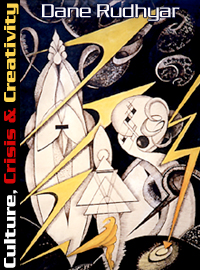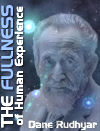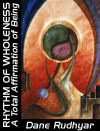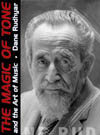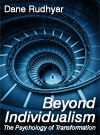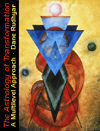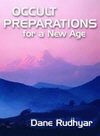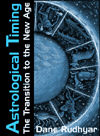Culture, Crisis & Creativity
by Dane Rudhyar
11. Creativity & the Individual's Role
in a Crisis Situation
There have been many recent research projects dealing with what is defined as creativity or the creative process. Because our contemporary Western Society is mainly concerned with individuals—their rights, their development, and the myriad of techniques devised to assist and normalize the actualization of their innate potentialities—these studies of creativity are almost always focused upon the root-causes, the necessary or optimal conditioning and the modes of operation of the creative process in individuals. These studies are motivated by the hope that when the process is better understood it will make it possible for a greater number of persons to release effectively and harmoniously the creativity now assumed to be latent in every human being.
Whether or not such an assumption is correct and whether it would serve humanity's essential destiny to arouse in every person an emotional eagerness to create something, whatever it be and for whatever purpose, is not the main issue. It can be stated nevertheless that such an emphasis placed upon the value of individual creativity, and the popularization of analyses of the creative process in personalities today regarded as especially creative, are developments related to the apparent fact that our Western culture-whole has reached the last phases of its cycle; these developments are typical symptoms of the vulgarization process always accompanying the closing period of any culture-whole. We would easily understand the reason for this if we realized that the state of the culture and the approach to creativity are definitely interrelated. It should be fairly evident that discussing the creative process in individuals without much reference to the state of the culture-whole in which these individuals are "being creative," and also to the character of their relationship—conscious or unconscious—to the culture and the social processes it features, makes very little sense. What essentially matters is the two-way relationship between the individual and his or her society. To consider the individual alone, as if he operated in an environmental vacuum, is as fundamentally meaningless as to discuss social, cultural, economic, and political processes with no regard to the individual human beings affected by these processes who, to a large extent, give them a conscious direction by formulating goals and means.
To be creative in twentieth century America is to a large extent different from being creative in the Europe of the seventeenth century. What the individual does and how he feels about it acquires its basic meaning from what his society needs and can accept at the time he is living and creating. As an individual, he may think of his activities as creative, yet if there is no cultural need for them, he will either not be able, for a variety of reasons, to bring his creative activity to completion, or else what he somehow completes will remain unrecognized and ineffectual; perhaps (in rare instances) he may be discovered much later and interpreted as a premature prophetic vision. Victor Hugo once stated that nothing is more powerful than an idea whose time has come. What he actually meant was that nothing is more effective and trans-formative than a creative activity (however it manifests) that fulfills the then operative need of a culture-whole toward which it is directed.
In other words, if we want to deal significantly with the creative process we have to consider the implied cultural need it is meant to fulfill. Whether or not the "creator" is fully aware of that need, is certainly not the main issue. Neither is what the process of "creating" does to the psychology of the individual in whom it operates the most important factor in the evaluation of the process. The essential value of the creative process, as I see it, is in the answer it gives to the collective need of a culture and a society, or of a special group or subculture within this society. It should be an eminently convincing answer, arousing in the people coming in contact with it not only the urge, but also the power to transform themselves in terms suggested by this creative answer.
To create is to transform; but the basic issue is what is being transformed. It may be raw materials (clay, wood, words, pigments, or the patterns of social behavior) to which a more integrated and meaning-releasing form is given; but it also could be the consciousness of human beings and their capacity to respond effectively to the challenge of a greater life.
In the first instance, one is dealing with what should more accurately be called productivity. The tribal artisan making beautiful pots or rugs, according to traditional models existing as prototypes in the collective unconscious of his people, is a "producer" rather than a "creator." He transforms the raw materials he uses into objects having, to him or his community, both a character of utility (whether he uses or sells them as artifacts) and an esthetic value. The artisan may modify the traditional forms and this may give him a feeling of exaltation or pride, especially if his community praises him rightly for what he has produced. Such a feeling is similar in nature to the emotional stimulation and the sense of increased power which a person receives from an especially successful sportive or even sexual performance. The organism-as-a-whole and its functions may be stimulated, but above all it is the performer's ego that is enhanced by a feeling of achievement. Because, in the performance, his biopsychic energies have reached a condition of greater fulfillment the artist-producer is more fully what he is.
On the other hand, in the above-mentioned second instance, when what is transformed is consciousness rather than materials of one kind or another, the creative individual, as he creates, becomes more than what he was. He has been moved by a power that is transcultural as well as transpersonal. Through him this power is able to evoke in others the desire, or perhaps the will, also to become more than they are, provided they open their consciousness and/or their feeling-responses to the magic of the creative act.
The dualism of creativity vs. productivity parallels that of magical will vs. esthetic pleasure. In the first case, a transpersonal power operates through the creator, or we should rather say the creative agent; in the second, the productive activity flows from the artist who produces objects or gives performances that meet the demands of the people of his culture, and perhaps in some instances of mankind as a whole. The demands of the culture-whole for objects of beauty or excellence should be clearly differentiated from the need of that culture for a radical transformation of its sense of value and its paradigms when a time of transition has come. When such a time comes it manifests outwardly in a "crisis," which (etymologically at least) means the opportunity for making a decision.(1)
A transition is a "going through"; what one goes through are boundaries. It is a passage from the know and the familiar to the as-yet-unknown. It implies a necessary process of "defamiliarization," and this refers to the disruptive, catabolic and "catesthetic" aspect of the truly creative process. All creative processes have their shadow aspect, but there need be no shadow in productivity, or (at the biological level) in procreation and in the various forms of procreatively oriented sexual activity. However, the creative-transformative (i.e., alchemical and regenerative) use of the sex-force has its shadow aspect; and this applies also to the now popularized process of the "raising of Kundalini."
The fundamental theme of this book is that our Western culture-whole—and by extension the whole of humanity subjected to its pervasive and catabolic influence—is, and has been for at least two centuries, in a situation of crisis. The crisis was brought about by the development of a new faculty, the analytical power of the intellectual mind, whose most fruitful field of operation is the world of physical matter, because all physical entities are infinitely divisible. This faculty in turn developed as the result of the general process of individualization of consciousness required for the fulfillment of Man's place and function on the planet, Earth.
Man, as the Individual, is intended to act as the conscious intermediary linking, through many and varied forms, the realm of spirit and the world of matter. Man is essentially Mind; but Mind is both "former" and "transformer." In its purest aspect Mind is the formative principle of the universe; but it contains within itself the power to destroy forms that have outlived their usefulness as alchemical vessels within which the "marriage" of spirit and matter can be performed. When the time has come for a new phase in the cyclic (or cyclocosmic) relationship between spirit and matter, this new relationship calls for a new type of "marriage" and this in turn requires a new type of forms within which the quality of the new relationships can come to maturity, as an embryo matures within a womb. Once matured this new quality of being and relating can radiate through the form's boundaries and bring a new inspiration to whatever it touches.
As soon as the evolutionary need for the new quality of humanness is felt, the old forms begin to break apart and to reveal their obsolescence. Then the crisis begins; it may be called catharsis at the psychopersonal level, or revolution at the sociopolitical level. At the telluric planetary level it may refer to a glacial period and an alteration of the direction of the polar axis. When the crisis begins, the relation of a significant group of individuals particularly sensitive and mentally alert to their society's needs takes on, at least potentially, a new character. A new role presents itself to them—a creative, transformative role.
If these individuals, consciously or only half-consciously, respond to the potentiality of assuming such a role, this response involves a twofold relation which to some extent is bound to affect their lives: a relation to the source of the creative activity, the character of which they may not be consciously or fully aware; and a new kind of relationship to the environment, group or society which is eventually to be transformed by that creative activity. This transformation may be interpreted by the people of the obsolescent cultural institutions as destructive or constructive, and to some extent it is both at the same time. The way it is interpreted could be considered of no great importance to the truly dedicated creative agent; yet what this interpretation does to the collective mentality of the new generation which will be most radically affected by the forms it takes can have a crucial importance. What is even more a determining factor is the quality of the relationship which the creative agent is able to sustain toward both the source of his or her creativity and the people to whom it is addressed. The creative agent should be able to understand both what it is he is tuning to, and the character of the need his culture has for his creative activity. He should understand his place and function in the whole process of evolution of his particular culture-whole.
Without such an at least intuitive understanding, the creative agent's relationship to either his source of inspiration or his culture (and most likely to both) tends to be inadequate because vitiated or distorted by egocentric reactions and mental or emotional confusion. The formulation of such an understanding may be difficult for the creative agent, for it inevitably implies a philosophical and historically aware mind; and such a mind need not be fully developed in the creative agent, or developed along the traditional lines of the old culture, which might be worse than not developed at all. Yet, in some way, the creative agent should be aware of what is taking place within him and at least of the ultimate purpose of his creative process. If he is not aware of being an instrumentality through which a creative power takes form this most likely (and perhaps always) means that the creative process working through him has only a catabolic or catesthetic character, even though he may feel during the creative act the same personal emotional exaltation as that experienced by a creative agent consciously and transpersonally dedicated to a purpose of collective transformation.
If the men and women of our present-day culture are fascinated by technique, always eager to know the "how to" of every doing, and intent on producing more of "bigger and better" things, it is because they consider and value almost everything in terms of how an individual person feels about it. If some type of activity feels good to a person, and it increases his or her material and psychological welfare and productivity, then—it is believed—everybody should learn how to act in the same or a basically similar manner; thus psychologists study the "successful" artist or business executive and attempt to extract from such a study "recipes for success."
This is a spiritually meaningless endeavor. Its results add to the process of vulgarization dominating the last period of the life-span of a culture-whole. Everybody must create so as to feel better, it seems! But the results are not really "creative." More things are produced, more canvases painted, more novels written, more of everything to glut the psychomental environment of people, each of whom has to feel what "successful people" are supposed to feel as they produce more and more and, in many cases, useless ego-titillating objects, including what passes as "works of art."
Productivity, even in the field of art, is not what should be called creativity. One may experience a real thrill at giving birth to forms, integrating pigments, chunks of clay, words or musical notes into forms which may or may not relate to the actual shapes or sounds of our physical experience or to the traditional conceptualizations of the culture in which one has been born and educated. But, in the sense I am using the term, this is no more creativity than is giving birth to a baby reproducing the generic pattern of biological integration long established by the human species. To give birth to an entity or object organized by a formative power replicating its blue-prints ad infinitum according to a standardized procedure is to produce, not to create. Creation implies transformation, a definite act of radical reorganization by, or if it is a truly significant creative act, through a mind dynamited by spirit—the power said to forever "make everything new."
Spirit creates, culture reproduces. Spirit releases a new creative impulse which the creative-formative mind then objectivizes as archetypes. Spirit sounds forth the Tone, the AUM of a new cycle—or it may be a subcycle or sub-subcycle; mind concretizes the Tone into "forms of power." When personified by the Avatar, or the Hero whose great deeds anchor the ideal archetypal structure of the emergent new cycle, these magical forms become prototypes. These prototypal realities of the world of collective existence are then seized upon by the poet. His inspirited mind makes them into myths; and upon these myths (prime symbols which in turn become paradigms in the hands of concept-builders and institution-builders) a culture-whole is formed. Once formed, the culture gives birth to men and women who produce the immense number of objects and systems multiplying the original prototypes. This multiplying operation is productivity; whether in the field of what we call art or in terms of the production of an ever increasing variety of wares.
To be productive is of course a highly satisfying personal activity for the producer. Productivity has ample room for what we call originality, because an individual person can be a new variation on an original theme. The producer's mind can succeed in integrating new elements provided by his individual (and therefore relatively unique) experience into the basic forms established by the traditional prototypes. It can extend the scope of operation of a prototype—let us say, in music, a sonata form—by incorporating it into new element abstracted from his experience; and obviously the personal experiences of individual human beings gradually changes as the culture-whole evolves from infancy to maturity and eventual death.
This basic cycle of organic unfoldment is not the only one to consider. Within it subcycles and sub-subcycles operate. When these smaller cycles reach the seed-condition of their own life-span, new prototypes—outstanding personages—appear personifying in every field the essential character of new subcycles and revealing the new quality of living, feeling, and thinking to be demonstrated during their limited span of operation. New symbols and a new style of life are "sung" by poets and given generalized meanings by philosophers. These seed men and women become the origins of new subsidiary developments, of variations on the primordial themes of the culture-whole.
Within the range of the periods of the culture's development which their activity has inspired, these seed-men are indeed "creative," but from the point of view of the culture-whole, their creativity is less characteristically different from the productivity of the rank and file of intelligent and mentally effective members of the culture, because it is less radically transformative. It produces variations on themes already existing within the culture's field of concepts and symbols. They did not create the themes, they only developed one or another of their inherent potentialities. Such a process of development does not necessitate a catabolic form-destroying prelude, because a new variation on a theme does not do away with the theme's basic identity.
Thus one can say that there are several levels of creativity. Because all human cultures can be seen as successive variations on the great planetary theme, Anthropos, the life-span of a culture-whole may be interpreted as a subcycle within the much vaster planetary cycle of the evolution of mankind. And if we wished to envision still larger cycles, we could speak of the evolution of the Earth as a planetary organism, of the solar system as a whole, of the galaxy. But then we would no longer deal with human creativity; we would have to think of divine creativity. The typically human organism and the human mind are able not merely to perceive, but to experience. A human, moreover, not only can experience a multitude of conditions and situations, he is able to communicate the meaning and value of what he has experienced. This can be done only through symbols which can most easily be transferred and developed. Myths are organizations of symbols. Algebra is a myth as much as is any religious cosmogony. Without man's mythopoetic capacity, there would be no human culture-whole.
In an advanced culture-whole the mythopoetic capacity takes on an extreme variety of forms, and once the process of individualization of human beings started in earnest, taking public sociopolitical and religious forms, a new factor began deeply to accept the human condition. The focusing of human attention upon the individual, and the recently intensified concern of individuals and of society as a whole with the problems resulting from living and functioning as an individual are now producing very drastic stresses and strain within our Western culture and all that remains of ancient cultures. Tensions are generated which must be solved. They can be solved only by a reformulation, and indeed a radical transformation of "the Myth of the Individual" which has dominated our Western culture.
The Myth of the Individual
To use Spengler's symbolic statement, this myth has for centuries in Europe and America taken the form of the "Faustian man," and I have already outlined the main characteristics of what Spengler meant in formulating the type. Faustian man has led us to experience spectacular trips to the moon and the transformation of atomic matter into energy and deadly fall-out. He has spread his inventive genius all over the globe; but in so doing he has poisoned the Earth's biosphere. He has achieved these extraordinary feats by allowing every individual to pursue his anarchistic egocentric interests and his uncontrolled cravings for ever-increasing power and productivity. This has been done in the name of laissez faire and of a freedom whose scope man's ego was supposed to be able to define and justify. In principle the ego definitions were supposed to obey much talked about religious and ethical directives; but in fact these have turned out to be enforced only as window-dressing and mainly in order to keep a power-elite in control.
The global crisis we all are facing is a struggle between myths. Mankind is struggling to build a new Myth of the Individual. Mankind is in a prolonged crisis of parturition; and the odds for miscarriage are still high. It needs great poets to name and sanctify a new image of the individual—and perhaps first of all an Avatar to give to the slowly emerging ideal of the "new individual" a substantiality which only a fascinating personification can give to an ideal. It must be "fascinating," because what is needed is a concentration of human energies upon one single image that for a time blots out all other images, as in the case of hypnotic trance.
The early Christians won over the might of Rome because their consciousness was hypnotized by the Christ myth: the most precious Son of God dying a horrible death out of incomprehensible love for each human being without distinction; thus "for me also." By this sacrificial love, I, you, every human being became sacralized, made valuable, made equal. What a vision, what a dream! In recent years the Baha'is who believe the Persian Prophet, Baha'u'llah, to be the Manifestation of God, Avatar for the New Age, have shown a similar faith which can truly be called "fascination." At all levels, the charismatic personages fascinate those who come in touch with them. If their charisma is not merely based on extraordinary vitality or personal radiance, if indeed it proves to be the manifestation of a transpersonal flow of creative power and not merely a passing answer to a superficial need of the people or of those who dictate collective fashions for personal gain, the charismatic personage and his or her deeds and words may become the foundations of a myth. But the foundations are not the entire building. On the foundations embodied in the Avatar's or the great Hero's life, the poet builds the visible and effectual form of the myth, while the philosopher seeks to convey its meaning to the community.
In nineteenth century America, Walt Whitman most closely filled the role of myth-creating poet for the ideal "New World" which fascinated millions of European immigrants. Jefferson, Lincoln, and many others contributed to the creation of the myth; the great millionaires of last century also brought living material to the formation and dissemination of the "American success story," a myth of great power to which millions of egos all over the world responded. Every historical period—every subcycle within the cycle of development of our Western culture and of the Greco-Latin and Hebraic cultures which not only preceded it but form with it a large coupling—has produced characteristic modifications and variations on the theme of "the individual." Some of these variations have ended in violent discords, others in strenuous and ineffectual modulations; and today we are faced with the awesome problem of dealing with the highly toxic products released into both the biosphere and the noosphere by the negative aspect of the forms Europe and America have given to the Myth of the Individual.
It seems unnecessary to restate here what has been said so many times concerning what these toxic results of our Western culture brand of individualism are. Our air, our homes, our cities, our newspapers, radios, and T.V. sets are so filled with them that for many people it is at times hard not to give up any attempt at creative transformation, so oppressed does one feel by a sense of futility and powerlessness. But this is precisely what one must not do or feel in a time of radical crisis and sociocultural catharsis. Carl Jung has vividly spoken of overcoming the "cramp in the conscious"; but there are other kinds of cramps to endure and allow to dissipate—spiritual cramps and gut-reactions. What today is essential for any potentially creative person (certainly a limited number, yet larger than one might think) is to stimulate in oneself the courage to see oneself and to act, in whatever way it might be, as myth-maker, as one of the small groups of individuals who are cocreating the new image of the individual.
How does one become cocreator of the new myth? Always at first by the individual manner in which one straightforwardly meets one's own crises within the context of the collective crisis of Western man. The myth-maker does not meet his crises in terms of strictly personal circumstances and idiosyncrasies; he sees in them symbols; he expands their meaning until they begin not merely to reflect, but bring to a personal focus, the crisis of his culture and, perhaps in the larger sense, of humanity. He lives a symbolic life. But it is the kind of symbolic life that fits in and gives meaning to a crisis situation; it is therefore a life of transformation, an alchemical life, a hierophanic life, revealing of the sacred nature of the world crisis.
Our world-crisis is "sacred" because it is a rite of passage and all rites of passage have a sacramental character. They contain, pulsating at their core, the power to make a new beginning—the power to re-create oneself, not as an isolated, lonely, and frustrated ego, but together with those who also have the vision, the lucidity of will, and the gut-strength to begin again, and by so doing to cocreate a new Image of Anthropos, a new Myth of the Individual. This great myth is central to the development of mankind at least for the last twenty-five centuries. Every human advance, every new faculty human beings have developed, every spiritual realization, every truly heroic and creative act or pronouncement has revolved around and contributed, positively or negatively, to form the Myth of the Individual. Everything revolves around the meaning we give to the individual. If our Western world is in a state of potentially tragic crisis it is because our culture as a whole has not been able to sustain the image of individual selfhood and of autonomous self-reliant and responsible "parenthood" which had been rather imprecisely and only partially outlined by the spiritual and intellectual leaders of our Greco-Hebraic tradition. Many of these leaders failed to understand the possibilities and the problems inherent in the glorification of the individual and all its by-products at our present stage of human evolution. They either did not provide sufficiently strong and precise safeguards, or else they tried to force the nascent realization of individual autonomy and rational mind-power into the straitjackets of religious dogma and intellectual dependence upon an already perverted or misunderstood Aristotelian empiricism.
Therefore our task is to illumine and reformulate the image of the individual, to understand how and when it took form, and in terms of humanity's place and function on our planet) for what purpose we must disengage it from the ruts of a materialistic and egocentric Western tradition. By seeing the individual in a new and challenging light, as the lightnings of the present historical storm strike our collective consciousness, we may give it a new philosophical and cosmic, as well as practical and psychosocial meaning. Thus in the very midst of the crisis we may receive the revelation, and as poets we may incorporate it into the new myth for which an incipient New Age is waiting.
How then can we formulate, or at least evoke the new image? What is, essentially, the individual?
The Principle of Integration, ONE
In the "cyclocosmic" philosophy I have outlined in my previously mentioned book The Planetarization of Consciousness, I have used the all-capitalized term, ONE, to represent that universal principle and power responsible for the fact that energy is released discontinuously in quanta (or units of energy) and that existence is to be conceived in terms of wholes , of units of existence we call entities. We have seen that existence is cyclic. It operates within a defined and structured field of activity, whether this be microcosmic or macrocosmic, an atom, a human organism, a planet, or a galaxy. A cycle of existence begins with a creative Impulse, a creative Word or Logos which releases a limited set of potentialities, immense perhaps, yet limited. These potentialities will be gradually actualized through a process whose life-span is also limited.
But why should there be existence and cycles of existence? The fairly obvious answer is that potentiality implies the urge to become actualized. We can however, express this in various ways. We can speak of a metacosmic, ineffable God "desiring" to manifest the infinite potentialities of His nature, a difficult concept to picture except in the anthropormorphic image of a glorious Being who forever creates new universes as a human artist produces many works, all of which do not exhaust his creative capacity. We can also imagine some kind of "infinite Ocean of potentiality," out of which periodically (and perhaps also simultaneously) universes of concrete substance emerge, objectivizing immense spurts of energy and, after passing through long cycles of growth and transformation, collapsing and returning to the undifferentiated metacosmic state of potentiality.
If we think of a series of such universes, we cannot avoid conceiving the process as endless, and there could be no reason to think of an absolute beginning or end. The series is endless because every release of new potentiality should be thought to operate in both a positive and negative manner; there will be some entities who will succeed in perfectly actualizing the potentiality being released in the beginning of the cycle, others who will fail to do so and will drop by the wayside and decay as waste products. And our human experience makes it possible for us to see how in theory the process can work out, as any new discovery or cultural advance seems inevitably to lead to both positive-constructive and negative-destructive results. The very fact of existence implies a dualism of results: success and failure, seed-perfection and decay. Therefore, a new cycle of existence is periodically needed to give to the decayed elements—the humus of disintegrated leaves—a new chance to experience the state of organic integration.
What does organic integration mean if not the joining together of two factors: the power of integration we usually call "life" and the mass of earth substances taken from the soil as foodstuff? In metaphysical terms we speak therefore of spirit and matter. Existence manifests as fields of activities within which spirit and matter are in the process of being integrated. This process needs a structure of some sort to make it effective and to give it form, at whatever level of activity it might be. This form is the product of mind. Spirit acting through mind integrates matter within the boundaries of structural fields of activity: this not merely at the physical level, but at other levels of subtler or coarser types of matter. What we call the cosmos is such a structured field of activity; so is the planet Earth, the atom, and the human organism.(2)
A human person is a structured field of activity operating at several interrelated and interacting levels. In popular terminology one speaks of body, mind and soul, the word soul being given a rather ambiguous and uncertain meaning. At the level of the physical organism, the human body, we can distinguish material elements (or chemical substances) being organically integrated by a principle of integration, life, acting through a structural web of lines of force to which esoteric philosophy usually refers as the "etheric" (and in some cases the "astral") field—unfortunately also spoken of as a "body." Thus the three basic above-mentioned factors of "spirit, mind, and matter" are present, but they manifest in the special manner pertaining to the realm of "physicality"; and the "matter" factor plays a dominant role which colors the whole level of physical activity.
A human person operates also at a level to which we generally refer as that of mental activity. According to the esoteric concepts developed in all advanced cultures, but particularly known today in their Hindu formulation popularized by the Theosophical Movement, and later on by Hindu swamis and yogis, the mind-field of activity is also basically threefold. It has a spiritual integrating factor, a structure through which this factor works, and a substantial base which manifests as a kind of "mind-stuff," as yet mostly unperceived by modern scientists and investigators. At that level of mental activity the spiritual integrating factor is no longer "life" (as we know it at the physical level), but a power that sustains and unifies all mental activity. It is the power responsible for what we call "individuality" or the I am-realization. (I have referred to it in the past as individual Identity, or as the "individual soul," and to the field of mental activity as "the ideity field."). It is individual because "indivisible." If what we call in psychological terms a breakdown of the mind, split personality, or schizophrenia occurs in a human being, this does not mean that this principle of individuality becomes "divided," but rather that it ceases to be effective. What breaks down is the mental structure through which it operates, the breakdown of the structure either renders this operation impossible, or at least partially or temporarily suspends it. What we call psychological complexes, innate tendencies and, at a more collective or generic level, archetypes, refers to the structural aspect of the mind-field (or ideity field).
As to the level at which the Spirit-factor of the above-mentioned metaphysical trinity operates in a most central and dominant manner, we today know very little about its existence per se. We refer to it in a metacosmic sense as the three aspects of the Deity, of the three persons of the Catholic and the popular Hindu Trinity: Father, Son, and Holy Spirit, or Brahma, Vishnu, and Shiva. By so doing however, we only create a myth, the Deity Myth, which probably obscures rather than elucidates the operation of whatever it is that is responsible for the process of cosmic existence.
In the symbolic language of modem Theosophy and in relation to man's being, the trinity of principles at the level of activity dominated by spirit is that of Atma, Buddhi, and Manas. Atma refers to pure unconditioned Spirit; a "mere breath" without substance or identity (wrote H. P. Blavatsky) perhaps therefore pure Motion or rhythm. Buddhi gives to this rhythmic activity a substantial foundation—its involutionary aspect is divine creative energy; its evolutionary aspect is divine wisdom. Manas refers to the conditioning and particularizing principle of structure, and therefore can be related to—and, in a sense but not exactly, identified with—what at the level of the ideity-field is "individuality." In terms of the process of involution one may speak of it as the primordial desire to manifest. At the close of the evolutionary arc of the cycle it is the desire for individual existence which is the last obstacle to be overcome by the "individual soul" (and the mind it operates in) before reaching liberation or nirvana, the extinguishing of all desires.
What then do I mean by "the individuals' with reference to the planetary crisis mankind is now experiencing and to the need for a new Image of Anthropos?
The individual is the human being operating as mind integrated by the principle of individuality (the I-am principle)—ideally, mind in a harmoniously structured fullness of mental substance. But in order to understand the function such a mind and the principle of individuality operating at the center of its mandala-field are meant to fill in the total scheme of unfoldment of planetary existence, we should first of all consider the place they occupy in the scheme. The human individual stands at the mid-point of existence. He occupies the "middle realm." He is essentially the intermediary and the mediator. His function is to bring together, to connect, correlate, and integrate spirit and matter.
What we have next to realize is that at the core of the three basic levels of cosmic activity—spirit, mind, and matter—the principle of integration, ONE, operates. It operates as pure, undifferentiated spirit, the Atman, in the transcendent field of spiritual activity; it operates as the I-am principle (the individuality or individual identity) at the level of mind; it operates as "life" at the level of organization of physical or chemical particles. It is the same principle at all three levels, a principle endowed with power. This power is irreducible and undefeatable; yet it may be challenged for long ages by solely mental beings who have cut their individualized will from the Spirit and are "all-ego." But these beings of total spiritual darkness inevitably face dissolution at the close of a more or less vast cycle of existence.
Individuality is power; it is the power of integration, ONE, operating through mind. But being in the middle of the dualism of spirit and matter, mind can be attracted by either pole. The I-am power centralizing the mind's activity can be so attracted, so fascinated by either spirit or matter, that it loses the sense of its essential function, which is to bring together, to firmly link and (eventually) to completely integrate these two poles of existence. The individual can become spirit-mad or matter-mad; and because at this time of racial evolution on our planet the forces of materiality are stronger than those of spirituality, it is far easier for the individual to be fascinated by the exciting play of material-biological energies than by the rarefied atmosphere of spiritual ecstasies and insubstantial bliss.
In the vitalistic age of tribal development during which human beings normally operated at the biopsychic level of activity and seed-multiplication (agriculture and cattle-raising), the human mind had mostly to be the servant of the power of life. But once the process of individualization began to affect the collective or public consciousness of mankind, especially in the Western world, what used to be biospheric norm: the real meaning of "fate" began to take a new character. The mentality of the whole culture became "materialistic" in a new, conscious and individualized way—in a destructive way. Mind, aware of its place in the universal scheme, turned away from it. Materialism became the betrayal of the individual's function.
The beginning of the process of individualization, which emphasized activity at the level of the mind, occurred long before our Western culture and the preceding Hellenic or Greco-Latin culture took form. The coming of the Promethean host had given to mankind the possibility of experiencing the mysterious fire of I-am-ness and of developing a structural capacity for "reflective" self-consciousness. But this possibility could only be realized under very rigid safeguards and within the precincts of sanctuaries; thus, in relatively rare cases, through initiations implying a transfer of function (and not merely power) from Initiator to long-tested disciples. But since the day of Buddha, and even more Christ, the process of individualization has begun to operate publicly and on a large scale. This is, twenty-five centuries later, the essential cause of the unrest our Euro-American culture has brought to the world and of the entire crisis man is facing. Unless this cause is understood, there can be no lasting solution to humanity's problems, to the human crisis of growth and, shall we say, to our global menopause?
Mankind is indeed facing a crisis similar to the "change of life" experienced by individual men and women in their forties or fifties. It is a biological and a psychosocial turning point. Both the individual person and the organizational character of human society are confronted with a radical change. This change has a truly planetary character. It implies the need for a fundamental reorientation of consciousness and a repolarization of human activity at the level of mind-activity; and the central problem is a re-evaluation of the meaning and function of individuality. The feeling of being I-myself must be given a new meaning. And perhaps the only way to consciously grasp this new meaning is to realize that the individual experiencing this I-feeling stands at the mid-point between spirit and matter. The very fact that we can say consciously and deliberately "I am" should reveal to us that the human individual, stands at the crossroads of existence, mediator between spirit and matter.
If we clearly and powerfully realize the character and meaning of this stand, we are potentially able to create a new Myth of the Individual. We can anchor the new myth in a metaphysical understanding of what this cosmic place of the individual entails. We can "see" the human archetypal manifestation of the crossroads of existence, and of the function of intermediary between spirit and matter belonging to whoever assumes such a position. If our "seeing" is clear and penetrating, we can deduce a wealth of images and symbols from such an experience in consciousness. These in their togetherness constitute the Myth of the Individual.
Gautama the Buddha extolled the Middle Way. Jesus presented himself as Son of Man and Son of God—thus as the point of convergence of the human and the divine fields of existence. In the Christ-Individual the two currents meet. This meeting is the substance of the Myth of the Individual. The new Image of Anthropos is revealed in that meeting at the crossroads of existence. It is that meeting, which should lead to a merging. The philosopher may speak of the meeting of opposites, la réconciliation des contraires. The mystic may glory in the dialogue of I and Thou. The individual is the meeting, the dialogue that eventually may merge into the unison of the silence of a realization beyond all conceivable words and symbols. He is the symbol to end all symbols, because the individual is a lens through which, if the lens is clear and well-formed, ONE can operate. Man, as the individual, is ONE in its most complete, most integrating focalization; because, in the individual the wholeness of existence can be integrated and focused in work. This work is an activity that encompasses both the realm of spirit and the realm of matter. Through this activity compassion takes form.
Many, names have been offered to characterize the new Image of Anthropos that is rising in the consciousness and in the heart of future-oriented creative persons in search of a focalizing concept for the work of transformation. What such a name should evoke is the deepest, most characteristic and most sublime function of Humanity standing at the center of the cosmic interplay of spirit and matter, focusing through his translucent mind the universal Presence of ONE, the Integrator; the Compassionate Individual, in whose plenitude all the polarities of existence are reconciled and merge in a magic Tone, whose vibrations stir in all beings, whether in heaven or earth, the will to transformation and to ever more encompassing wholeness.
1. The word, "opportunity" literally means "reaching the harbor." When the sailor after a long voyage reaches a harbor he is challenged, both to adjust to a new situation in a totally different life-situation and to use the experience born of new relationships for his growth—personal growth, or growth of his wealth if he is able to sell products obtained from distant lands. The sailor may have to decide whether to return to his ship and his travels within a limited but totally familiar area of relationships, or to make a new home in a new country. This is a situation of crisis. Return
2. Physicists have remarked, many years ago, that, in size, a human being stands midway between the immensely vast cosmos and the infinitesimally small atom or atomic particles. Is this a privileged position from the point of view of the cosmos and its Creator, or is it perhaps that, as the limits of man's capacity for perception aided by ever more complex and refined machines extend, they are extended at the same time and for the same reasons in both directions? If the second alternative is accepted, this means that the limits of the universe man can directly and indirectly perceive are determined by the human mind standing at the center of a circle whose radii simply reflect the acuity of that mind. The modern universe of science is therefore basically as anthropocentric as the world of archaic religions and philosophies. The world is our world, our mandala. It reflects what man is in any historical period. Our collective consciousness expanded when a vaster picture of the universe was presented to us by galactic astronomy and atomic physics; but this vaster picture resulted from the expansion of our intellectual powers. Thus the basic fact is not that man's mind has grown in scope thanks to science, but that science has expanded because the human mind has actualized, further than before, some of its inherent potentialities. The old statement, "Man is the measure of all things," remains as valid as ever. The today often repeated statement that man is an insignificant entity so small when he is compared to a galaxy reveals an irrational bias. Why not say: How vast is man's body compared to an electron? Both the galaxy and the electron simply reveal the phase in the unfoldment of consciousness mankind has reached today. Consciousness can not be quantitatively measured in any absolute sense, any more than one can state how much of the "infinite Ocean of Potentiality" is actualized today. The recent mathematical concept of degrees or levels of infinity is essentially meaningless because, even if it can be intellectually justified, it simply pushes further the idea of infinity, as there could be infinite levels of "infinities." Return
12. The Work of Civilization
Copyright © 1977 by Dane Rudhyar.
All Rights Reserved.
See Notices for full copyright statement and conditions of use.
Web design copyright © 2000-2004 by Michael R. Meyer.
All Rights Reserved.


